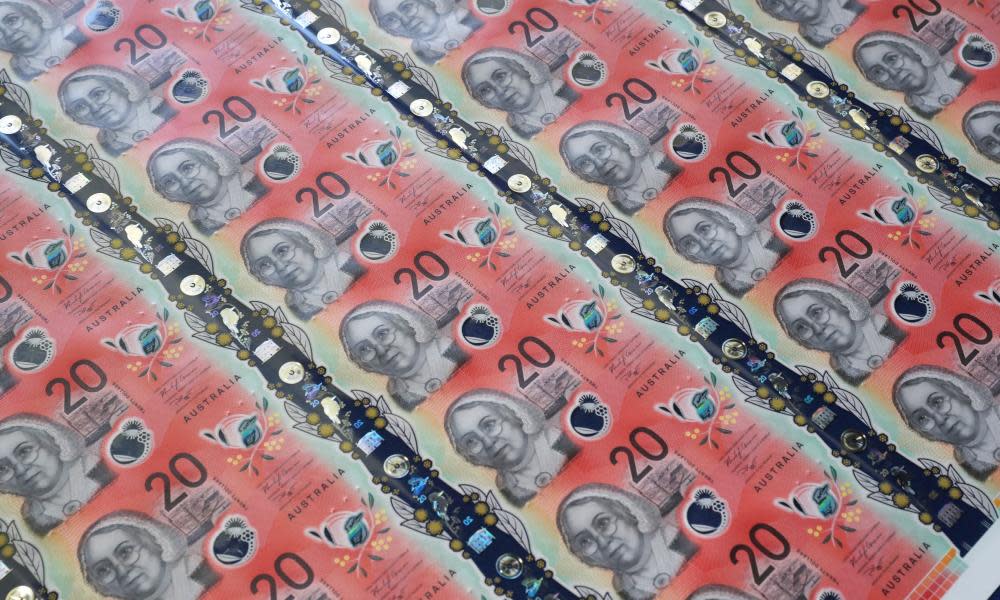Few signs of economic life as inflation stays stuck in its rut

The latest inflation figures released on Wednesday by the Australian Bureau of Statistics show that aside from factors associated with the drought and some overseas issues, there remains little energy in the economy, and we have now had four full years of average core inflation growth below the Reserve Bank’s target of 2%.
On first glance it might seem like the December inflation figure show a bit of a revival in demand. After all, in the last quarter of 2019, the consumer price index increased by 0.7% – the fastest quarterly growth since September 2016.
But it is clear upon closer inspection that the growth is due to not to an increase in demand, but a reduction in supply – notably among food.
Related: We're working, but not as much as we want to – and that keeps wages low | Greg Jericho
The price jump also is rather more a blip than anything ongoing, as the average of the Reserve Bank’s two core inflation measures – the trimmed mean and weighted median – saw growth of just 0.4%:
In annual growth terms, even with the big 0.7% quarterly jump, the CPI only grew by 1.8% - below the 2% lower band of the RBA’s target range, while the average core inflation growth was a rather pathetic 1.4%:
What the overall figures also hide is that once again the increase in excise on tobacco products was a big factor.
Over the past year tobacco prices grew by 14%. If we exclude alcohol and tobacco, the overall CPI increased in 2019 by just 1.4%:
The gap between the total CPI growth and the growth of CPI excluding tobacco and alcohol is now as large as it has been since the Rudd government’s excise increase in 2010 and is just another reminder that if you want to immediately reduce your cost of living, quit smoking now!
The other big factor was the price of food. But this was not because we had all suddenly decided we were flush with money and wanted to eat more, it was because the supply of various food was reduced.
Related: A new decade is likely to bring another year of low wages growth | Greg Jericho
The ABS notes that there were two factors at play here – the drought and the spread of African swine fever in Asia. The drought reduced the supply of items such as “grapes, melons, onions, potatoes, eggs, rice and prawns”. This led to a 6.8% increase in fruit prices on average (the biggest jump for two years).
The African swine fever led to an increase in world prices of meat, which flows through to the prices we pay at our local butcher and supermarket.
The prices of beef and veal increased 2.9% in the December quarter and pork went up 4.7% - the biggest quarterly increase for over a decade:
On the other side of the ledger, the price of water and soft drinks fell 2.2%, reflecting the common occurrence during the early summer months.
Another price increase outside our control was that of automotive fuel.
Petrol prices grew by 4.4% in the December quarter – actually higher that the growth for the whole of 2019. But even here there was nowhere near the high level of price increases we have seen in the past decade:
2019 also saw some of the lowest increases in housing costs for some time. The 0.18% average cost of rents prices is the lowest ever calendar year increase recorded.
Electricity prices fell 3.5% on average and gas rose 1.4% – the lowest calendar year rise since 2015.
But these price rises were quite varied across the country. While Sydney saw rent prices fall by 0.8%, they jumped 5.6% in Hobart. Similarly while the price of electricity fell 6.2% for people living in Melbourne, last year it rose 1.7% for those in Perth and 2.0% for those in Hobart:
It means that inflation is growing fastest in Hobart – up 2.7% of the past year, compared with just 0.5% in Darwin and 1.6% in Perth:
But even with some increased growth of prices in Melbourne, inflation there lies just on the bottom of the RBA’s target range of 2%.
As a result there is little sense that these figures will affect the likelihood of an interest rate cut and the value of the Australian dollar barely moved after the figures were released.
While the market does not expect a rate cut next week, the expectation is the RBA will wait to see what happens in the May budget. And unless some growth appears in the economy in the next few months, or the government embarks on a stimulus package, the likelihood of the Reserve Bank cutting the cash rate to a record low of 0.5% by the middle of the year remains strong.
Greg Jericho writes on economics for Guardian Australia


